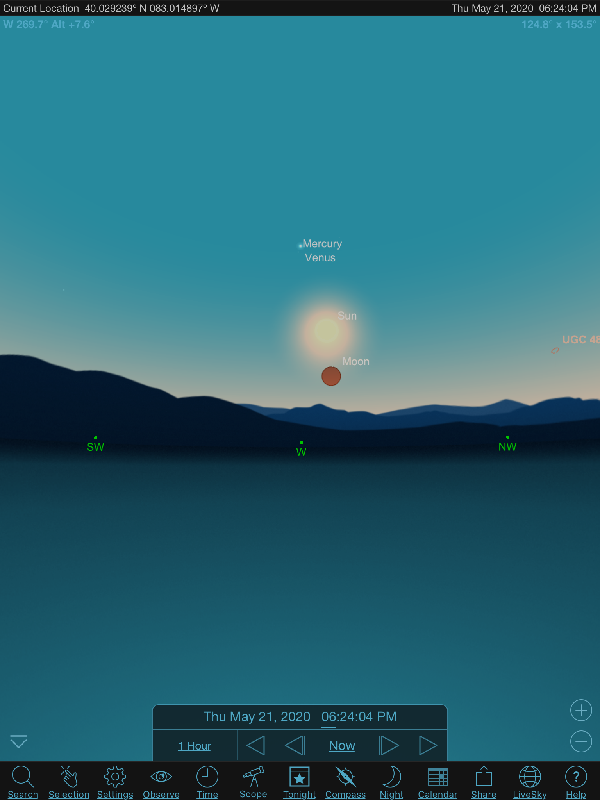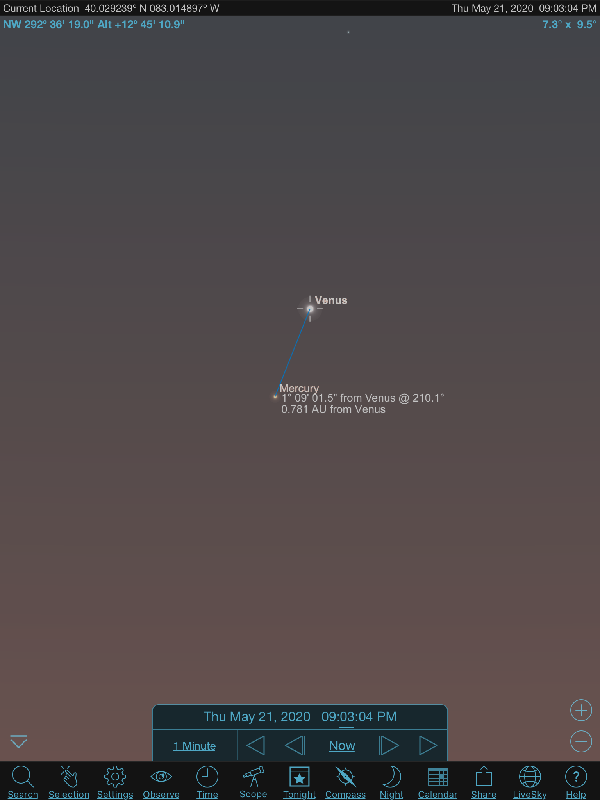Page 1 of 1
APOD: Phases of Venus (2020 May 21)
Posted: Thu May 21, 2020 4:06 am
by APOD Robot
 Phases of Venus
Explanation: Just as
Phases of Venus
Explanation: Just as the Moon goes
through phases, Venus' visible sunlit hemisphere waxes and wanes. This composite of
backyard telescopic images illustrates the steady changes for
Venus during its current stint as our evening star, as the inner planet grows larger but narrows to a thin crescent. Images from bottom to top were taken during 2020 on dates February 27, March 20, April 14, April 24, May 8, and May 14. Gliding along its interior orbit between Earth and Sun, Venus grows larger during that period because it is approaching planet Earth. Its crescent narrows, though, as Venus swings closer to our line-of-sight to the Sun. Closest to the Earth-Sun line but passing about 1/2 degree north of the Sun on June 3, Venus will reach a (non-judgmental)
inferior conjunction. Soon after, Venus will shine clearly above the eastern horizon in predawn skies as planet Earth's
morning star. After sunset tonight look for Venus above the western horizon and you can also spot
elusive innermost planet Mercury.
Re: APOD: Phases of Venus (2020 May 21)
Posted: Thu May 21, 2020 10:49 am
by De58te
This picture reminds us just how ingrained we are about thinking that in astrophotography that North is at the top of the photo. Presuming that where Venus is lit up that the Sun would be above the picture, yet the description says that Venus will be 1/2 degree north of the Sun, so then it is South at the top of the photo and North is at the bottom. Am I wrong?
Re: APOD: Phases of Venus (2020 May 21)
Posted: Thu May 21, 2020 11:09 am
by orin stepanek
Oh Venus; no planet shall come between us!

Re: APOD: Phases of Venus (2020 May 21)
Posted: Thu May 21, 2020 1:03 pm
by GeoXXXXX
This is a wonderful chance to view Venus and Mercury extremely close together relative high in the sky.
If you need to get your bearings here they ate an hour before sunset

This shot is just after sunset a little zoomed in to approximate the naked eye view.Notice how high they are riding in the sky, both are over 15 degrees above the horizon. That is about the width of two fists (thumbs tucked in) at arms length. Venus is currently getting closer to the Sun from our view point every day while Mercury is still going up!

A closeup showing the distance between them, only a little more than two full moons! You can see them both at once through a pair of binoculars! Not too often you can do that!

If you want to test your eyesight this is a great chance to do it. Venus is about 55 arc seconds across right now. While nominal human eyesight can detect objects as a non-point source at about 60 arc-seconds size (Other modifiers includes contrast and other factors as well) people with superb eyesight can make it out as a crescent

. Give it a try!
BTW Don’t waste your time trying to perceive Mercury’s disc, it’ only 6 arc-seconds across!
Please forgive me if I have butchered the explanations in this post!
Eric
Re: APOD: Phases of Venus (2020 May 21)
Posted: Thu May 21, 2020 1:07 pm
by GeoXXXXX
De58te wrote: ↑Thu May 21, 2020 10:49 am
This picture reminds us just how ingrained we are about thinking that in astrophotography that North is at the top of the photo. Presuming that where Venus is lit up that the Sun would be above the picture, yet the description says that Venus will be 1/2 degree north of the Sun, so then it is South at the top of the photo and North is at the bottom. Am I wrong?
Actually North is on the left, they laid Venus on it’s side!
Re: APOD: Phases of Venus (2020 May 21)
Posted: Thu May 21, 2020 1:42 pm
by Sa Ji Tario
In her book Astronomy, Cecilia Payne Gaposchkin says that the light reflected by Venus and captured on Earth always gives the same intensity value. Observe that as the planet gets closer to its visible area it is larger but its illuminated area drops, which causes the intensity of received light to always have the same value.-
Some of this has already been said by José Comas Solá when referring to the inner planets, in his book Astronomía (by chance of identical names, only that in Comas Solá's illustrations are drawings, therefore, older)
Re: APOD: Phases of Venus (2020 May 21)
Posted: Thu May 21, 2020 1:57 pm
by neufer
https://www.etymonline.com/search?q=phase wrote:
phase (n.) 1705, "phase of the moon, particular recurrent appearance presented by the moon (or Mercury or Venus) at a particular time," back-formed as a singular from Modern Latin phases, plural of phasis, from Greek phasis "appearance" (of a star), "phase" (of the moon), from stem of phainein "to show, to make appear".
Latin singular phasis was used in English from 1660 for each of the aspects of the moon. General (non-lunar) sense of "aspect, appearance, stage of development at a particular time" is attested by 1841. Meaning "temporary difficult period" (especially in reference to adolescents) is attested from 1913.
Re: APOD: Phases of Venus (2020 May 21)
Posted: Thu May 21, 2020 2:03 pm
by Chris Peterson
Sa Ji Tario wrote: ↑Thu May 21, 2020 1:42 pm
In her book Astronomy, Cecilia Payne Gaposchkin says that the light reflected by Venus and captured on Earth always gives the same intensity value. Observe that as the planet gets closer to its visible area it is larger but its illuminated area drops, which causes the intensity of received light to always have the same value.-
Some of this has already been said by José Comas Solá when referring to the inner planets, in his book Astronomía (by chance of identical names, only that in Comas Solá's illustrations are drawings, therefore, older)
That's approximately true. We generally consider Venus to have an apparent magnitude of -4. In actuality it varies from -3.7 to -4.5 as its distance and phase change. Visually that's not a big difference, but it is quite apparent to an observer paying attention.
Re: APOD: Phases of Venus (2020 May 21)
Posted: Thu May 21, 2020 2:51 pm
by johnnydeep
Hmm. I note that all these crescents are horizontal. Does that mean something particular about where the pictures were taken on the Earth? Is a horizontal crescent mandatory (or even possible) for an inferior planet when viewed from Earth? Or was this just depicted this way for artistic effect? Sorry if the answer should be obvious, but I always have trouble visualizing planetary geometry in 3D

Re: APOD: Phases of Venus (2020 May 21)
Posted: Thu May 21, 2020 3:03 pm
by Chris Peterson
johnnydeep wrote: ↑Thu May 21, 2020 2:51 pm
Hmm. I note that all these crescents are horizontal. Does that mean something particular about where the pictures were taken on the Earth? Is a horizontal crescent mandatory (or even possible) for an inferior planet when viewed from Earth? Or was this just depicted this way for artistic effect? Sorry if the answer should be obvious, but I always have trouble visualizing planetary geometry in 3D :-(
The images have been aligned this way as an artistic choice. Venus has only a small axial tilt, so its crescent phases basically define north and south with respect to the ecliptic. The apparent angle we see it at (with respect to the horizon) depends on our latitude and where the planet is in the sky.
Re: APOD: Phases of Venus (2020 May 21)
Posted: Thu May 21, 2020 4:00 pm
by johnnydeep
Chris Peterson wrote: ↑Thu May 21, 2020 3:03 pm
johnnydeep wrote: ↑Thu May 21, 2020 2:51 pm
Hmm. I note that all these crescents are horizontal. Does that mean something particular about where the pictures were taken on the Earth? Is a horizontal crescent mandatory (or even possible) for an inferior planet when viewed from Earth? Or was this just depicted this way for artistic effect? Sorry if the answer should be obvious, but I always have trouble visualizing planetary geometry in 3D

The images have been aligned this way as an artistic choice. Venus has only a small axial tilt, so its crescent phases basically define north and south with respect to the ecliptic. The apparent angle we see it at (with respect to the horizon) depends on our latitude and where the planet is in the sky.
Ok, that makes sense to me - thanks!
Re: APOD: Phases of Venus (2020 May 21)
Posted: Thu May 21, 2020 4:42 pm
by Sa Ji Tario
Cris, thanks for the clarification
Re: APOD: Phases of Venus (2020 May 21)
Posted: Thu May 21, 2020 5:19 pm
by MarkBour
That's a lovely composition and gives a very helpful comparison of the progression.
Thanks for that nice work, Richard Addis!
(And thanks to our APOD astronomers and curators for finding and sharing this.)
It might be fun to lay out these images on a depiction of the planetary orbits.
Something like the (very inaccurate) rendering at the right:
Re: APOD: Phases of Venus (2020 May 21)
Posted: Thu May 21, 2020 6:59 pm
by neufer
MarkBour wrote: ↑Thu May 21, 2020 5:19 pm
That's a lovely composition and gives a very helpful comparison of the progression.
(And thanks to our APOD astronomers and curators for finding and sharing this.)
It might be fun to lay out these images on a depiction of the planetary orbits.
Something like the (very inaccurate) rendering at the right:
The synodic period between inferior conjunctions =
583.92 Earth days:
Almost exactly the same as 5 solar Venusian solar days =
583.75 Earth days.
Hence, every time Venus is at inferior conjunction,
Earth observes the same nighttime side of Venus.*
That nighttime side of Venus even slowly rotates
retrograde
....as if it is constantly tracking Earth.
Venus seems to be very very leery of the Earth

-----------------------------------------------------------------------------------
* Over the long 4-transit Venus cycle [of 243 years]
there will be 152 inferior conjunctions during which
we will observe Venus to rotate only ~80º in latitude.
Re: APOD: Phases of Venus (2020 May 21)
Posted: Thu May 21, 2020 7:00 pm
by Ann
MarkBour wrote: ↑Thu May 21, 2020 5:19 pm
That's a lovely composition and gives a very helpful comparison of the progression.
Thanks for that nice work, Richard Addis!
(And thanks to our APOD astronomers and curators for finding and sharing this.)
Capture.JPG
It might be fun to lay out these images on a depiction of the planetary orbits.
Something like the (very inaccurate) rendering at the right:
Thanks, Mark, that's beautiful!

Ann
Re: APOD: Phases of Venus (2020 May 21)
Posted: Tue May 26, 2020 2:23 pm
by TheZuke!
Thanks MarkBour and neufer for the illustrations!
 Phases of Venus
Phases of Venus


